A Song of Sixpence
By Tim Campbell-Green
Part of the joy of working with the archaeology here at the Blackden Trust is that you are never quite certain where researching an object will take you. Even the most seemingly mundane objects can open up a whole world you didn’t know existed. Objects tell stories.
This coin is a good example of that.
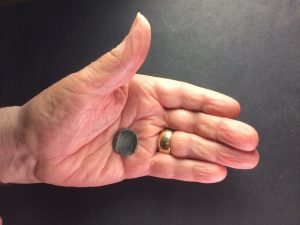
Found in the garden, the coin is a silver sixpence of William III (1694 – 1702) minted between 1694 and 1699. It is very worn and bent, and not particularly inspiring… at first glance at least. However, whilst cataloguing and conserving the coin, one of our 6th Form volunteers noticed that it was bent in a peculiar way; rather than it being twisted or simply bent in two, it was bent twice in opposite directions to produce an ‘S’ shape. Also, wear on the coin along the creases suggests that the coin had been kept for some time following the bending, possibly in a pocket or purse This was a deliberate bending, rather than an accident, and it prompted the question,” Why bend a coin like this?”
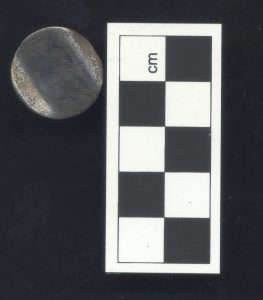
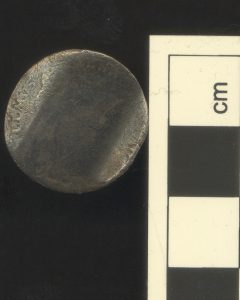
The answer is fascinating.
The tradition of bending coins seems to have begun in the medieval period, and the first reference we have is from the late 12th century in the story of a monk who injured himself in a riding accident. In pain, the monk took a coin and bent it, dedicating it to St Cuthbert, asking for his help and promising to make a pilgrimage to the saint’s shrine on Lindisfarne. Having made the pilgrimage and placing the coin on the shrine, a miracle occurred and the monk recovered.
In essence, a deal was struck between the monk and the saint: in return for help, a promise was made of a coin and a pilgrimage to promote the saint’s glory. The coin then became a token of dedication, a keepsake, and a symbol of a promise of faith to that individual saint.
This pattern of bending and dedicating a coin in order to receive help seems to have been common in medieval England, and there are numerous examples recorded in various sources. For example, we hear of a William Child, a constable from Peterborough, bending a coin over his ‘dead’ child in the name of Simon de Montfort and miraculously the child recovered. A coin bent over a still-born child and dedicated to St. Richard of Chichester effected an immediate cure. A sailor in the midst of a storm at sea bent a coin with the words “I vow myself and this penny to my lord St. Wulfstan”, the storm passed with the miracle attributed to Wulfstan. And a certain Katherine Bailey, blind in one eye, was told by a stranger to bend a coin to Henry VI; making a mental promise to do so, she found she could see with both eyes.
The practice even helped criminals; in the early 1290’s, a certain William Cragh was hanged for arson and 13 counts of homicide. Taken from the gallows as dead, a coin was bent over him in the name of St. Thomas Cantilupe, and miraculously he lived.
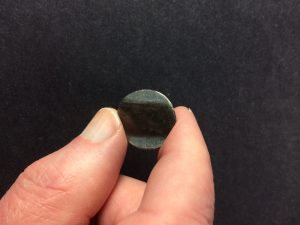
Bending coins was not confined to helping people either; an injured falcon belonging to a Geoffrey d’Abitot was brought back to life by the bending of a penny dedicated to St. Thomas Cantilupe, whilst a blind horse was cured after a penny was bent on its behalf.
The religious upheaval of the Reformation meant the role of saints within the Church was very much downplayed, and the practice of bending a coin lost it religious meaning. However, coins continued to be bent and given as token of love or remembrance. The meaning is the same – faith, promise, and devotion – but the object of this faith and devotion shifted from a saint to a person, and from the sacred to the secular.
In 1557, Alice Benden, a protestant martyr, gave her brother a ‘bowed shilling’ as a keepsake on the occasion of her execution, and in a letter dated 1790 we read the following: “I have a bent sixpence with a hole through it, which was given by my only brother as a keepsake”. More commonly, though, they were given as love tokens by one, or both, of the partners as a way of promising their faithfulness, and showing their devotion to one another. Indeed, the giving of a coin was a similar gesture to giving an engagement ring, and was often understood to be a statement of betrothal or marriage. In 1715, Lady Bridget Osbourne, eldest daughter of the 2nd Duke of Leeds, gave the Reverend William Williams half a gold coin “which she had almost bent double with her teeth” as a way of announcing her intention to marry him. The ensuing clandestine marriage produced a scandal that was played out in court, with the coin figuring quite prominently within the case. It is interesting that here the protagonists are educated middle and upper class individuals, suggesting that all elements of society understood the gesture.
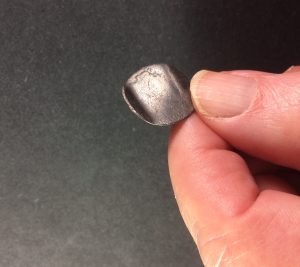
Bent coins were also considered lucky, and people carried them on their watch chains, or around their necks. They were also used to protect against witchcraft; milk that wouldn’t churn properly had a bent coin dipped in it to reverse the spell that was assumed to be the cause of the problem. We also read about more direct action against alleged witches, animals believed to be the witch in disguise were shot with a bent coin to lift a curse.
As a practice, coin bending seems to have ceased by the early Victorian period, although examples are known from as late as 1860’s. After this period, and into the early 20th century, coins were still used as keepsakes and love tokens, but were inscribed with names, verse, dates, and pictures instead.
From saints and their miracles, to love and good luck, and all from a chance find of a simple bent coin, prompt the question, “What other stories lie amongst the archaeology?”
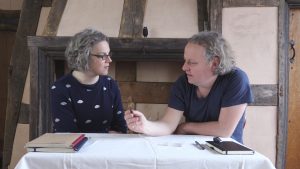
© Tim Campbell-Green
